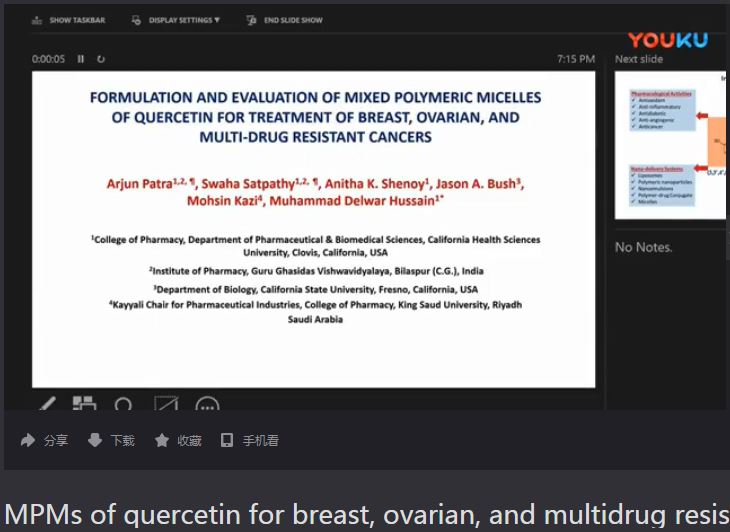9 0 5 7 8
论文已发表
注册即可获取德孚的最新动态
IF 收录期刊
- 2.6 Breast Cancer (Dove Med Press)
- 3.9 Clin Epidemiol
- 3.3 Cancer Manag Res
- 3.9 Infect Drug Resist
- 3.6 Clin Interv Aging
- 4.8 Drug Des Dev Ther
- 2.8 Int J Chronic Obstr
- 8.0 Int J Nanomed
- 2.3 Int J Women's Health
- 3.2 Neuropsych Dis Treat
- 4.0 OncoTargets Ther
- 2.2 Patient Prefer Adher
- 2.8 Ther Clin Risk Manag
- 2.7 J Pain Res
- 3.3 Diabet Metab Synd Ob
- 4.3 Psychol Res Behav Ma
- 3.4 Nat Sci Sleep
- 1.9 Pharmgenomics Pers Med
- 3.5 Risk Manag Healthc Policy
- 4.5 J Inflamm Res
- 2.3 Int J Gen Med
- 4.1 J Hepatocell Carcinoma
- 3.2 J Asthma Allergy
- 2.3 Clin Cosmet Investig Dermatol
- 3.3 J Multidiscip Healthc

Formulation and evaluation of mixed polymeric micelles of quercetin for treatment of breast, ovarian, and multidrug resistant cancers
Authors Patra A, Satpathy S, Shenoy AK, Bush JA, Kazi M, Hussain MD
Received 3 October 2017
Accepted for publication 9 December 2017
Published 16 May 2018 Volume 2018:13 Pages 2869—2881
DOI https://doi.org/10.2147/IJN.S153094
Checked for plagiarism Yes
Review by Single-blind
Peer reviewers approved by Dr Alexander Kharlamov
Peer reviewer comments 4
Editor who approved publication: Prof. Dr. Thomas J Webster
Background: Quercetin (QCT), a naturally occurring flavonoid has a wide array
of pharmacological properties such as anticancer, antioxidant and
anti-inflammatory activities. QCT has low solubility in water and poor
bioavailability, which limited its use as a therapeutic molecule. Polymeric
micelles (PMs) is a novel drug delivery system having characteristics like
smaller particle size, higher drug loading, sustained drug release, high
stability, increased cellular uptake and improved therapeutic potential. In the
present study, we have formulated and characterized mixed PMs (MPMs) containing
QCT for increasing its anticancer potential.
Methods: The MPMs were prepared by thin film hydration method,
and their physicochemical properties were characterized. The in vitro
anticancer activity of the MPMs were tested in breast (MCF-7 and MDA-MB-231,
epithelial and metastatic cancer cell lines, respectively), and ovarian (SKOV-3
and NCI/ADR, epithelial and multi-drug resistant cell lines, respectively)
cancer.
Results: The optimal MPM formulations were obtained from
Pluronic polymers, P123 and P407 with molar ratio of 7:3 (A16); and P123, P407
and TPGS in the molar ratio of 7:2:1 (A22). The size of the particles before
lyophilization (24.83±0.44 nm) and after lyophilization (37.10±4.23 nm), drug
loading (8.75±0.41%), and encapsulation efficiency (87.48±4.15%) for
formulation A16 were determined. For formulation A22, the particle size before
lyophilization, after lyophilization, drug loading and encapsulation efficiency
were 26.37±2.19 nm, 45.88±13.80 nm, 9.01±0.11% and 90.07±1.09%, respectively.
The MPMs exhibited sustained release of QCT compared to free QCT as
demonstrated from in vitro release experiments. The solubility of QCT was
markedly improved compared to pure QCT. The MPMs were highly stable in aqueous
media as demonstrated by their low critical micelle concentration. The
concentration which inhibited 50% growth (IC50) values of both
micellar preparations in all the cancer cell lines were significantly less compared
to free QCT.
Conclusion: Both the MPMs containing QCT could be used for
effective delivery to different type of cancer and may be considered for
further development.
Keywords: quercetin,
mixed polymeric micelle, Pluronics, TPGS, breast cancer, ovarian cancer,
multidrug resistant cancer
摘要视频链接:MPMs of quercetin for breast,
ovarian, and multidrug resistant cancers
